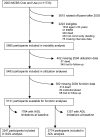Ability to walk 1/4 mile predicts subsequent disability, mortality, and health care costs
- PMID: 20972641
- PMCID: PMC3019329
- DOI: 10.1007/s11606-010-1543-2
Ability to walk 1/4 mile predicts subsequent disability, mortality, and health care costs
Abstract
Background: Mobility, such as walking 1/4 mile, is a valuable but underutilized health indicator among older adults. For mobility to be successfully integrated into clinical practice and health policy, an easily assessed marker that predicts subsequent health outcomes is required.
Objective: To determine the association between mobility, defined as self-reported ability to walk 1/4 mile, and mortality, functional decline, and health care utilization and costs during the subsequent year.
Design: Analysis of longitudinal data from the 2003-2004 Medicare Current Beneficiary Survey, a nationally representative sample of Medicare beneficiaries.
Participants: Participants comprised 5895 community-dwelling adults aged 65 years or older enrolled in Medicare.
Main measures: Mobility (self-reported ability to walk 1/4 mile), mortality, incident difficulty with activities of daily living (ADLs), total annual health care costs, and hospitalization rates.
Key results: Among older adults, 28% reported difficulty and 17% inability to walk 1/4 mile at baseline. Compared to those without difficulty and adjusting for demographics, socioeconomic status, chronic conditions, and health behaviors, mortality was greater in those with difficulty [AOR (95% CI): 1.57 (1.10-2.24)] and inability [AOR (CI): 2.73 (1.79-4.15)]. New functional disability also occurred more frequently as self-reported ability to walk 1/4 mile declined (subsequent incident disability among those with no difficulty, difficulty, or inability to walk 1/4 mile at baseline was 11%, 29%, and 47% for instrumental ADLs, and 4%, 14%, and 23% for basic ADLs). Total annual health care costs were $2773 higher (95% CI $1443-4102) in persons with difficulty and $3919 higher (CI $1948-5890) in those who were unable. For each 100 persons, older adults reporting difficulty walking 1/4 mile at baseline experienced an additional 14 hospitalizations (95% CI 8-20), and those who were unable experienced an additional 22 hospitalizations (CI 14-30) during the follow-up period, compared to persons without walking difficulty.
Conclusions: Mobility disability, a simple self-report measure, is a powerful predictor of future health, function, and utilization independent of usual health and demographic indicators. Mobility disability may be used to target high-risk patients for care management and preventive interventions.
Similar articles
-
Biopsychosocial characteristics of community-dwelling older adults with limited ability to walk one-quarter of a mile.J Am Geriatr Soc. 2010 Mar;58(3):539-44. doi: 10.1111/j.1532-5415.2010.02727.x. Epub 2010 Feb 22. J Am Geriatr Soc. 2010. PMID: 20210817 Free PMC article.
-
Association of long-distance corridor walk performance with mortality, cardiovascular disease, mobility limitation, and disability.JAMA. 2006 May 3;295(17):2018-26. doi: 10.1001/jama.295.17.2018. JAMA. 2006. PMID: 16670410
-
Preclinical mobility disability predicts incident mobility disability in older women.J Gerontol A Biol Sci Med Sci. 2000 Jan;55(1):M43-52. doi: 10.1093/gerona/55.1.m43. J Gerontol A Biol Sci Med Sci. 2000. PMID: 10719772
-
CAPABLE program improves disability in multiple randomized trials.J Am Geriatr Soc. 2021 Dec;69(12):3631-3640. doi: 10.1111/jgs.17383. Epub 2021 Jul 27. J Am Geriatr Soc. 2021. PMID: 34314516 Review.
-
The energetic pathway to mobility loss: an emerging new framework for longitudinal studies on aging.J Am Geriatr Soc. 2010 Oct;58 Suppl 2(Suppl 2):S329-36. doi: 10.1111/j.1532-5415.2010.02913.x. J Am Geriatr Soc. 2010. PMID: 21029063 Free PMC article. Review.
Cited by
-
Mobility in Older Community-Dwelling Persons: A Narrative Review.Front Physiol. 2020 Sep 15;11:881. doi: 10.3389/fphys.2020.00881. eCollection 2020. Front Physiol. 2020. PMID: 33041836 Free PMC article. Review.
-
Lifestyle interventions and independence for elders study: recruitment and baseline characteristics.J Gerontol A Biol Sci Med Sci. 2013 Dec;68(12):1549-58. doi: 10.1093/gerona/glt064. Epub 2013 May 28. J Gerontol A Biol Sci Med Sci. 2013. PMID: 23716501 Free PMC article. Clinical Trial.
-
Prevalence and Predictors of Ambulatory Care Physicians' Documentation of Mobility Limitations in Older Adults.Arch Phys Med Rehabil. 2023 May;104(5):719-727. doi: 10.1016/j.apmr.2022.11.018. Epub 2023 Jan 31. Arch Phys Med Rehabil. 2023. PMID: 36731767 Free PMC article.
-
Subjective social status and functional and mobility impairments among older adults: life satisfaction and depression as mediators and moderators.BMC Geriatr. 2023 Oct 23;23(1):685. doi: 10.1186/s12877-023-04380-5. BMC Geriatr. 2023. PMID: 37872470 Free PMC article.
-
Pathways, Contributors, and Correlates of Functional Limitation Across Specialties: Workshop Summary.J Gerontol A Biol Sci Med Sci. 2019 Mar 14;74(4):534-543. doi: 10.1093/gerona/gly093. J Gerontol A Biol Sci Med Sci. 2019. PMID: 29697758 Free PMC article. Review.
References
Publication types
MeSH terms
Grants and funding
LinkOut - more resources
Full Text Sources
Other Literature Sources
Medical


